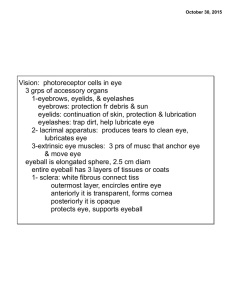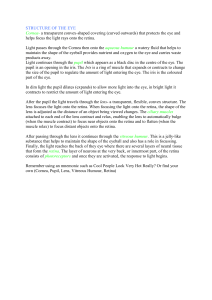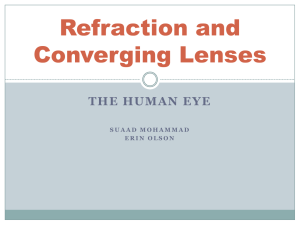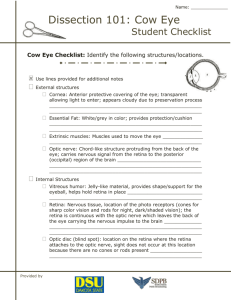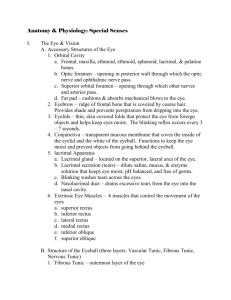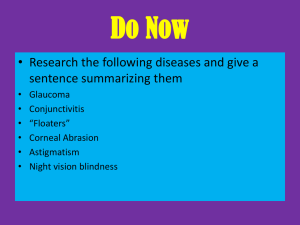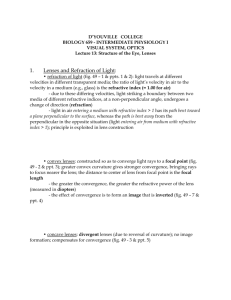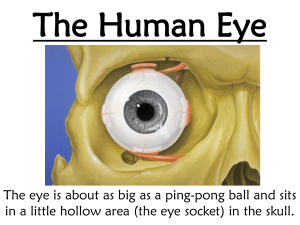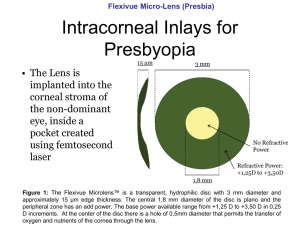12.3 - Lens Technologies and The Human Eye
advertisement
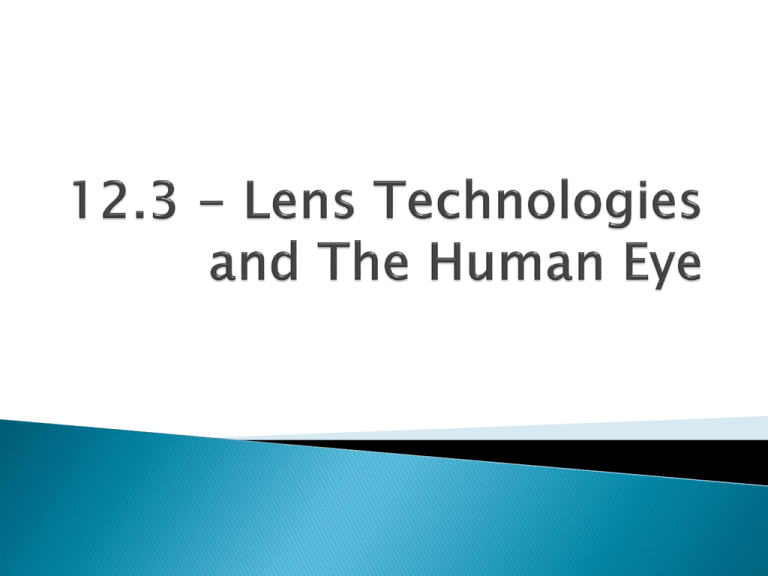
Cornea: ◦ Tissue that forms a transparent, curved structure in front of the eye ◦ Refracts light before it enters the eye Retina: ◦ A layer of cells (known as rods and cones) that respond to light and initiate nerve responses Rod cells are very sensitive to light but cannot distinguish between colours Cone cells detect colour Recall: normally, when an object moves in front of a lens, its image moves; moving the lens has the same effect This won’t work in the eye – images from different distances need to focus on the retina, but the distance between the retina and the lens is always the same So what happens? The cornea refracts light in the same way regardless of the location of the object The lens, however, can change shape and refract light to a different extent This allows it to focus light from both nearby and distant objects onto the retina The ciliary muscles (or ciliary bodies) make the lens shorter and thicker by pulling on it This process is called accomodation To focus on a nearby object, the curvature of the lens needs to be greater because it needs to refract light more Cameras are designed very much like eyes Both have lenses that focus light on a light-sensitive material ◦ Retina in the eye ◦ Film or CCD in a camera Lens of the eye changes shape in order to focus on objects at different distances Lens of the camera must be moved in and out to focus on objects at different distances Eye has an iris (or pupil) that controls the amount of light entering it Camera also has an iris (or aperture) to control the amount of light Myopia is near-sightedness ◦ The eyes cannot focus on distant objects Caused by the eyeball being too long The image forms in front of the retina, not on it By the time light rays reach the retina they have begun to diverge, and the image looks fuzzy Adding a diverging lens spreads out the parallel light rays before they reach the eye The rays that are separating from each other appear to be coming from an object that is closer to the eye Due to the higher angle of incidence, when the eye refracts the light, it is focused correctly on the retina Hyperopia is far-sightedness ◦ The eyes cannot focus on nearby objects Caused by the eyeball being too short Light rays entering the eye reach the retina before they converge at a point, causing the image to be blurry Adding a converging lens bends the rays slightly inward before they enter the eye The lens of the eye then refracts them more, and causes the rays to be correctly focused on the retina As a person ages, the lenses of the eye become stiffer, and the ciliary muscles can no longer make them change shape This condition is called presbyopia People with presbyopia cannot focus on nearby objects, but this is not farsightedness (which is caused by an incorrect eyeball length) If someone is already nearsighted and gets presbyopia, they cannot focus on distant OR nearby objects! To correct this condition, people wear bifocals Bifocals are lenses with two parts ◦ The top part of the lens corrects for nearsightedness ◦ A small section of the lower part with a different curvature helps the eye focus on nearby objects Bifocal contact lenses are also available Astigmatism is blurred or distorted vision that is usually caused by an incorrectly shaped cornea Instead of being rounded, the cornea is oval-shaped Part of an image might be in focus, but the rest of the image is blurry This is corrected by using lenses that have a cylindrical curvature ◦ Refracts incident light rays along one axis only
